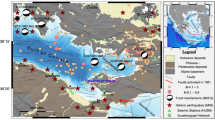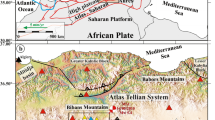Abstract
We studied the variations in spatial and temporal clustering of earthquake activity (during 2001–2013) in the Kachchh seismic zone, Gujarat, India, by precisely relocating 3478 events using a joint hypocentral determination (JHD) relocation technique, and high-quality arrival times of 21032 P- and 20870 S-waves. Temporal disposition of estimated station corrections of P- and S-waves suggests that the fluid flow in the causative fault zone of the 2001 Bhuj mainshock increased during 2001–2010, while it reduced during 2011–2013, due to the healing process associated with the perturbed Kachchh fault zone. We also estimated the isotropic seismic diffusivities from epicentral growth patterns, which are found to be much lower than those observed for reservoir-induced seismicity sites in the world. Finally, we analysed the spatial and temporal evolution of this earthquake sequence by solving the diffusion equation of pore-pressure relaxation caused by co- and post-seismic stress changes associated with earthquakes. The value of the isotropic diffusivity is estimated to be 100 m2/s for the Kachchh rift zone. This gives a higher permeability (after a lapse time of 14 years from the occurrence of the 2001 Bhuj mainshock) in comparison to those observed for other intraplate regions in the world. Our results suggest that the observed spatio-temporal migration of seismicity is consistent with the shallow (meteoric water circulation at 0–10 km depths) and deeper (metamorphic fluid and volatile CO2 circulation at 10–40 km depths) fluid flows in the permeable and fractured causative fault zone of the 2001 Bhuj earthquake.






Similar content being viewed by others
References
Antolik M and Dreger D S 2003 Rupture process of the 26 January 2001 Mw 7.6 Bhuj, India, earthquake from teleseismic broadband data; Bull. Seismol. Soc. Am. 93 1235–1248.
Antonioli A, Chiaraluce L, Cocco M and Piccinini D 2005 Fluid flow and seismicity pattern: Evidence from the 1997 Umbria–Marche (central Italy) seismic sequence; Geophys. Res. Lett. 32 L13011.
Biswas S K 1987 Regional framework, structure and evolution of the western marginal basins of India; Tectonophys. 135 302–327.
Biswas S K 2005 A review of structure and tectonics of Kutch Basin, western India, with special reference to earthquake; Curr. Sci. 88 (10) 15–30.
Chung W Y and Gao H 1995 Source parameters of the Anjar earthquake of July 21, 1956, India and its seismotectonic implications for the Kutch rift basin; Tectonophys. 242 281–292.
Courtillot V, Besse J, Vandamme D, Montigny R, Jaeger J J and Cappetta H 1986 Deccan flood basalts at the Cretaceous/Tertiary boundary? Earth Planet. Sci. Lett. 80 361–374.
Crampin S, Volti T, Chastin S, Gudmundsson A and Stefansson R 2002 Indication of high pore-fluid pressures in a seismically-active fault zone; Geophys. J. Int. 151 F1–F5.
Gangopadhyay A and Talwani P 2003 Symptomatic features of intraplate earthquakes; Seismol. Res. Lett. 74 (6) 863–883.
Gliko A 2011 Potential seismic sources and seismic precursors – the base for real earthquake prediction; (ed.) Gliko A O, Moscow 2011 (in Russian).
Got J L, Frechet J and Klein F W 1994 Deep fault plane geometry inferred from multiplet relative relocation beneath the south flank of Kilauea; J. Geophys. Res. 99 15,375–15,386.
Gudmundsson A 2000 Active fault zones and groundwater flow; Geophys. Res. Lett. 27 (18) 2993–2996.
Gupta H K, Harinarayana T, Kousalya M, Mishra D C, Mohan I, Rao N P, Raju P S, Rastogi B K, Reddy P R and Sarkar D 2001 Bhuj earthquake of 26 January 2001; J. Geol. Soc. India 57 275–278.
Havskov J and Ottemoller L 2003 SEISAN: The earthquake analysis softwares for Windows, Solaris and Linux, Version 8.0; Institute of Solid Earth Physics, University of Bergen, Norway, 400p.
Kayal J R, Zhao D, Mishra O P, De R and Singh O P 2002 The 2001 Bhuj earthquake: Tomographic evidence for fluids at the hypocentre and its implications for rupture nucleation; Geophys. Res. Lett. 29 5–4.
Mandal P 2007 Sediment thicknesses and Qs vs. Qp relations in the Kachchh rift basin, Gujarat, India using Sp converted phases; Pure. Appl. Geophys. 164 135–160.
Mandal P 2009a Estimation of static stress changes after the 2001 Bhuj earthquake: Implications towards the Northward spatial migration of the seismic activity in Kachchh, Gujarat; J. Geol. Soc. India 74 487–497.
Mandal P 2009b Crustal shear wave splitting in the Epicentral Zone of the 2001 Mw 7.7 Bhuj Earthquake, Gujarat, India; J. Geodyn. 47 246–258.
Mandal P 2012 Passive source seismic imaging of the crust and upper mantle beneath the 2001 Mw 7.7 Bhuj earthquake region, Gujarat, India; Bull. Seismol. Soc. Am. 102 (1) 252–266.
Mandal P and Chadha R K 2008 Three-dimensional velocity imaging of the Kachchh seismic zone, Gujarat, India; Tectonophys. 452 1–16.
Mandal P and Horton S 2007 Relocation of aftershocks, focal mechanisms and stress inversion: Implications toward the seismotectonics of the causative fault zone of Mw 7.6 2001 Bhuj earthquake (India); Tectonophys. 429 61–78.
Mandal P and Pandey O P 2010 Relocation of aftershocks of the 2001 Bhuj earthquake: A new insight into seismotectonics of the Kachchh seismic zone, Gujarat, India ; J. Geodyn. 49 254–260.
Mandal P and Pujol J 2006 Seismic imaging of the aftershock zone of the 2001 Mw 7.7 Bhuj earthquake, India; Geophys. Res. Lett. 33 L05309 1–4.
Mandal P, Rastogi B K, Satyanarayana H V S and Kousalya M 2004 Results from local earthquake velocity tomography: Implications toward the source process involved in generating the 2001 Bhuj Earthquake in the lower crust beneath Kachchh (India); Bull. Seismol. Soc. Am. 94 (2) 633–649.
Mandal P, Narsaiah R, Sairam B, Satyamurty C and Raju I P 2006 Relocation of early and late aftershocks of the 2001 Bhuj earthquake using joint hypocentral determination (JHD) technique: Implication toward the continued aftershock activity for more than four years; Pure Appl. Geophys. 163 1561–1581.
Mandal P, Chadha R K, Raju I P, Kumar N, Satyamurthy C, Narsaiah R and Maji A 2007 Coulomb static stress variations in the Kachchh, Gujarat, India: Implications for the occurrences of two recent earthquakes (Mw 5.6) in the 2001 Bhuj earthquake region; Geophys. J. Int. 169 281–285.
Manning C E and Ingebritsen S E 1999 Permeability of the continental crust: Implications of geothermal data and metamorphic systems; Rev. Geophys. 37 (1) 127– 150.
McCalpin J P and Thakkar M G 2003 2001 Bhuj–Kachchh earthquake: Surface faulting and its relation with neotectonics and regional structures, Gujarat, western India; Ann. Geophys.-Italy 46 (5) 937–956.
Miller S A, Collettini C, Chiaraluce L, Cocco M, Barchi M, Boris J and Kraus P 2004 Aftershocks driven by a high-pressure CO2 source at depth; Nature 427 724–727.
Mishra O P and Zhao D 2003 Crack density, saturation rate and porosity at the 2001 Bhuj, India, earthquake hypocentre: A fluid-driven earthquake; Earth Planet. Sci. Lett. 212 393–405.
Negishi H, Mori J, Sato H, Singh R P and Kumar S 2001 Aftershocks and slip distribution of mainshock: A comprehensive survey of the 26 January 2001 earthquake (Mw 7.7) in the state of Gujarat, India; Research Report on Natural Disasters, December 2001, pp. 33–45.
Noir J, Jacques E, Bekri S, Adler P M, Tapponier P and King G C P 1997 Fluid flow triggered migration of events in the 1989 Dobi earthquake sequence of central Afar; Geophys. Res. Lett. 24 2335–2338.
Nur A and Booker J R 1972 Aftershocks caused by pore fluid flow? Science 175 885–887.
Padhy S and Crampin S 2006 High pore-fluid pressures at Bhuj, inferred from 90∘-flips in shear-wave polarizations; Geophys. J. Int. 164 370–376.
Poupinet G, Ellsworth W L and Frechet J 1984 Monitoring velocity variations in the crust using earthquake doublets: An application to the Calaveras fault, California; J. Geophys. Res. 89 5719–5731.
Pujol J 1988 Comments on the joint determination of hypocentres and station corrections; Bull. Seismol. Soc. Am. 78 1179–1189.
Rastogi B K, Aggrawal S K, Rao N and Choudhury P 2013 Triggered/migrated seismicity due to the 2001 Mw 7.6 Bhuj earthquake, western India; Natural Hazards 65 (2) 1085–1107.
Rodkin M and Mandal P 2012 A possible physical mechanism for the unusually long sequence of seismic activity following the 2001 Bhuj Mw 7.7 earthquake, Gujarat, India; Tectonophys. 536/537 101–109.
Sarkar D, Sain K, Reddy P R, Catchings R D and Mooney W D 2007 Seismic – reflection images of the crust beneath the 2001 M=7.7 Kutch (Bhuj) epicentral region, western India; Geol. Soc. Am. Spec. Paper 425 319–327.
Shapiro S A, Audigane P and Royer J J 1999 Large scale in situ permeability tensor of rocks from induced microseismicity; Geophys. J. Int. 137 207–213.
Shapiro S A, Patzig R, Rothert E and Rindshwentner J 2003 Triggering of seismicity by pore-pressure perturbations: Permeability-related signature of the phenomenon; Pure Appl. Geophys. 160 1051–1066.
Sheldon H and Micklethwaite S 2007 Damage and permeability around faults: Implications for mineralization; Geology 35 (10) 903–906.
Talwani P and Acree S 1984 Pore-pressure diffusion and the mechanism of reservoir-induced seismicity; Pure Appl. Geophys. 6 947–965.
To A, Burgmann R and Pollitz F 2006 Post-seismic deformation and stress changes following the 1819 Rann of Kachchh, India earthquake: Was the 2001 Bhuj earthquake a triggered event? Geophys. Res. Lett. 31 L13609, 1–4.
Acknowledgements
The authors are grateful to the Director, NGRI, for the support and permission to publish this work. The Ministry of Earth Sciences (MoES), New Delhi and CSIR–NGRI, Hyderabad (under the Heart Project) supported this work.
Author information
Authors and Affiliations
Corresponding author
Additional information
Corresponding editor: Pawan Dewangan
Rights and permissions
About this article
Cite this article
Mandal, P., Kumar, M. & Biswas, K. Evidence for a fluid flow triggered spatio-temporal migration of seismicity in the 2001 Mw 7.7 Bhuj earthquake region, Gujarat, India, during 2001–2013. J Earth Syst Sci 125, 1285–1298 (2016). https://doi.org/10.1007/s12040-016-0729-3
Received:
Revised:
Accepted:
Published:
Issue Date:
DOI: https://doi.org/10.1007/s12040-016-0729-3




